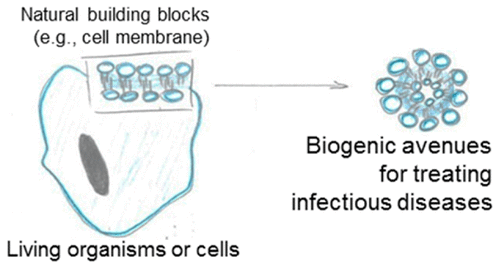当前位置:
X-MOL 学术
›
ACS Infect. Dis.
›
论文详情
Our official English website, www.x-mol.net, welcomes your
feedback! (Note: you will need to create a separate account there.)
Biogenic and Biomimetic Carriers as Versatile Transporters To Treat Infections
ACS Infectious Diseases ( IF 4.0 ) Pub Date : 2018-03-19 00:00:00 , DOI: 10.1021/acsinfecdis.8b00030 Adriely Goes 1, 2 , Gregor Fuhrmann 1, 2
ACS Infectious Diseases ( IF 4.0 ) Pub Date : 2018-03-19 00:00:00 , DOI: 10.1021/acsinfecdis.8b00030 Adriely Goes 1, 2 , Gregor Fuhrmann 1, 2
Affiliation

|
Biogenic and biomimetic therapeutics are a relatively new class of systems that are of physiological origin and/or take advantage of natural pathways or aim at mimicking these to improve selective interaction with target tissue. The number of biogenic and bioengineered avenues for drug therapy and diagnostics has multiplied over the past years for many applications, indicating the high expectations associated with this biological route. Nevertheless, the use of “bio”-related approaches for treating or diagnosing infectious diseases is still rare. Given that infectious diseases, in particular bacterial resistances, are seriously on the rise, there is an urgent need to take advantage of biogenic and bioengineered systems to target these challenges. In this manuscript, we first give a definition of the various “bio” terms, including biogenic, biomimetic, bioinspired, and bioengineered and we highlight them using tangible applications in the field of infectious diseases. Our examples cover cell-derived systems, including bioengineered bacteria, virus-like particles, and different cell-mimetics. Moreover, we discuss natural and bioengineered particles such as extracellular vesicles from mammalian and bacterial sources and liposomes. A concluding section outlines the potential for biomaterial-related avenues to overcome challenges associated with difficult-to-treat infections. We critically discuss benefits and risks for these applications and give an outlook on the future of biogenic engineering.
中文翻译:

生物和仿生载体作为治疗感染的多功能转运蛋白。
生物仿生疗法和仿生疗法是一类相对较新的系统,其起源于生理和/或利用天然途径或旨在模仿这些途径来改善与靶组织的选择性相互作用。在过去的许多年中,用于药物治疗和诊断的生物基因和生物工程途径的数量成倍增加,这表明与这种生物途径相关的期望很高。然而,使用“生物”相关的方法来治疗或诊断传染病仍然很少。鉴于传染病,特别是细菌耐药性正在严重上升,迫切需要利用生物基因和生物工程系统来应对这些挑战。在此手稿中,我们首先给出各种“生物”术语的定义,包括生物基因,仿生,生物启发和生物工程技术,我们在传染病领域使用有形的应用来突出显示它们。我们的示例涵盖了细胞衍生的系统,包括生物工程细菌,病毒样颗粒和不同的模拟细胞。此外,我们讨论了天然和生物工程化的颗粒,例如来自哺乳动物和细菌来源的细胞外囊泡以及脂质体。结论部分概述了与生物材料有关的途径克服与难以治疗的感染相关的挑战的潜力。我们批判性地讨论了这些应用的益处和风险,并对生物工程的未来展望。包括生物工程细菌,病毒样颗粒和不同的细胞模拟物。此外,我们讨论了天然和生物工程化的颗粒,例如来自哺乳动物和细菌来源的细胞外囊泡以及脂质体。结论部分概述了与生物材料有关的途径克服与难以治疗的感染相关的挑战的潜力。我们批判性地讨论了这些应用的益处和风险,并对生物工程的未来展望。包括生物工程细菌,病毒样颗粒和不同的细胞模拟物。此外,我们讨论了天然和生物工程化的颗粒,例如来自哺乳动物和细菌来源的细胞外囊泡以及脂质体。结论部分概述了与生物材料有关的途径克服与难以治疗的感染相关的挑战的潜力。我们批判性地讨论了这些应用的益处和风险,并对生物工程的未来展望。
更新日期:2018-03-19
中文翻译:

生物和仿生载体作为治疗感染的多功能转运蛋白。
生物仿生疗法和仿生疗法是一类相对较新的系统,其起源于生理和/或利用天然途径或旨在模仿这些途径来改善与靶组织的选择性相互作用。在过去的许多年中,用于药物治疗和诊断的生物基因和生物工程途径的数量成倍增加,这表明与这种生物途径相关的期望很高。然而,使用“生物”相关的方法来治疗或诊断传染病仍然很少。鉴于传染病,特别是细菌耐药性正在严重上升,迫切需要利用生物基因和生物工程系统来应对这些挑战。在此手稿中,我们首先给出各种“生物”术语的定义,包括生物基因,仿生,生物启发和生物工程技术,我们在传染病领域使用有形的应用来突出显示它们。我们的示例涵盖了细胞衍生的系统,包括生物工程细菌,病毒样颗粒和不同的模拟细胞。此外,我们讨论了天然和生物工程化的颗粒,例如来自哺乳动物和细菌来源的细胞外囊泡以及脂质体。结论部分概述了与生物材料有关的途径克服与难以治疗的感染相关的挑战的潜力。我们批判性地讨论了这些应用的益处和风险,并对生物工程的未来展望。包括生物工程细菌,病毒样颗粒和不同的细胞模拟物。此外,我们讨论了天然和生物工程化的颗粒,例如来自哺乳动物和细菌来源的细胞外囊泡以及脂质体。结论部分概述了与生物材料有关的途径克服与难以治疗的感染相关的挑战的潜力。我们批判性地讨论了这些应用的益处和风险,并对生物工程的未来展望。包括生物工程细菌,病毒样颗粒和不同的细胞模拟物。此外,我们讨论了天然和生物工程化的颗粒,例如来自哺乳动物和细菌来源的细胞外囊泡以及脂质体。结论部分概述了与生物材料有关的途径克服与难以治疗的感染相关的挑战的潜力。我们批判性地讨论了这些应用的益处和风险,并对生物工程的未来展望。











































 京公网安备 11010802027423号
京公网安备 11010802027423号